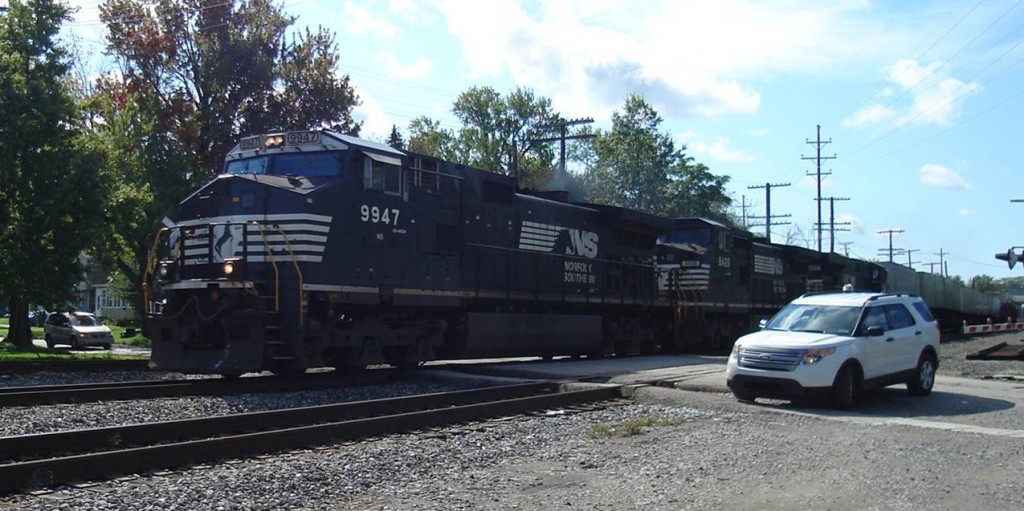



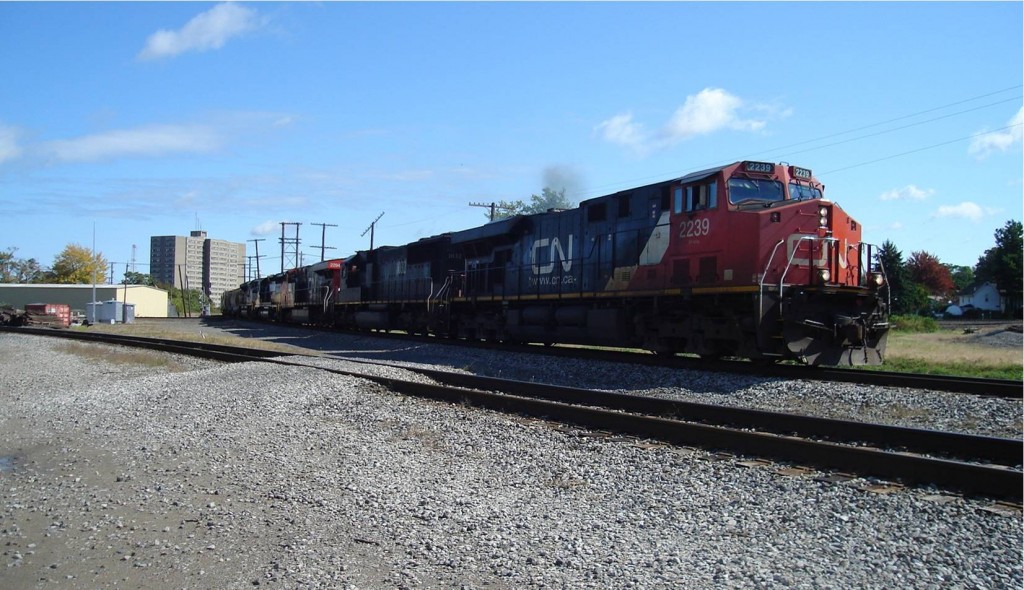
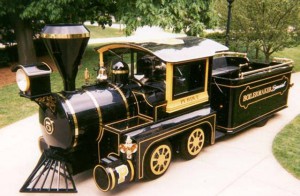 For many years Purdue operated the Schenectady No. 1 and No. 2, on a dynamometer in an engineering laboratory on the West Lafayette campus. These were 4-4-0 type steam locomotives manufactured by the Baldwin Locomotive Works of Philadelphia. At the time, Purdue did not have a mascot. After much debate, it was decided to build a locomotive on an automobile chassis. The choice allowed the mascot to build on Purdue’s engineering and railroading heritage, as well as represent the school’s nickname Boilermakers in a meaningful way. The Boilermaker nickname came about during the early years of Purdue football when rumors of the university enrolling burly boilermakers from the Monon Railroad shops in Lafayette as football players. The current mascot, Boilermaker Special V, was introduced in 1993. Submitted by Chris Dees.
For many years Purdue operated the Schenectady No. 1 and No. 2, on a dynamometer in an engineering laboratory on the West Lafayette campus. These were 4-4-0 type steam locomotives manufactured by the Baldwin Locomotive Works of Philadelphia. At the time, Purdue did not have a mascot. After much debate, it was decided to build a locomotive on an automobile chassis. The choice allowed the mascot to build on Purdue’s engineering and railroading heritage, as well as represent the school’s nickname Boilermakers in a meaningful way. The Boilermaker nickname came about during the early years of Purdue football when rumors of the university enrolling burly boilermakers from the Monon Railroad shops in Lafayette as football players. The current mascot, Boilermaker Special V, was introduced in 1993. Submitted by Chris Dees.
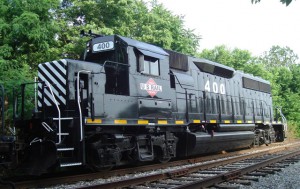 Back In Black: Newly arrived US Rail GP40 # 400 rests just north of the Wabash River bridge after switching the Rail America (TP&W) interchange at Van Tower in Logansport, Indiana. US Rail operates two former Winamac Southern (Pennsylvania RR) branches out of Logansport – one to Kokomo, the other to Flora. Date: June 17, 2011. Photographer: Chris Dees
Back In Black: Newly arrived US Rail GP40 # 400 rests just north of the Wabash River bridge after switching the Rail America (TP&W) interchange at Van Tower in Logansport, Indiana. US Rail operates two former Winamac Southern (Pennsylvania RR) branches out of Logansport – one to Kokomo, the other to Flora. Date: June 17, 2011. Photographer: Chris Dees
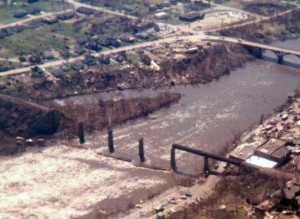 With the storm images from the south fresh on everyone’s minds, thought this historical photo would bring back memories from the 1974 Super Outbreak.
With the storm images from the south fresh on everyone’s minds, thought this historical photo would bring back memories from the 1974 Super Outbreak.
An F4 tornado struck Monticello (IN), resulting in an estimated $100 million dollars in damages.
Part of the destruction included the Penn Central Railroad trestle over the Tippecanoe River.
Many of the spans were ripped off their concrete piers and thrown yards upstream of the bridge. The bridge was rebuilt and continues to serve Rail America’s Toledo, Peoria & Western line to Logansport, Indiana. Photo courtesy of Tippecanoe County, Indiana Amateur Radio Emergency Services April 2011 meeting. – Chris Dees.
From Railway Age (www.railwayage.com)
Submitted by Chris Dees
GE Transportation said Friday that it intends to open a new 900,000 square foot locomotive manufacturing facility in Fort Worth, Tex., “to meet accelerating global demand.” GE said it will invest up to $96 million in the new plant and will create more than 500 new high-tech manufacturing jobs.
At the same time, GE Transportation also will expand its manufacturing workforce at its Erie, Pa., plant by hiring an additional 250 workers.
“GE Transportation is experiencing strong U.S. and global growth because of its technical leadership and we need to increase our manufacturing capacity and flexibility,” said GE Chairman and CEO Jeffrey Immelt. “This new state-of-the-art plant in Fort Worth, Texas will produce the world’s most advanced locomotives and transportation products, expand our service and repair capability, and create hundreds of new high-tech manufacturing jobs.”
“We are excited to expand our operational footprint in the United States to better serve our customers,” added Lorenzo Simonelli, President and CEO of GE Transportation. “We see robust growth in the U.S. and around the globe. A new site will help us to effectively respond to the cyclical demand in the transportation industry and to strengthen our overall position.”
The State of Texas will commit up to $4.2 million in incentives toward the project through the Texas Enterprise Fund (TEF). GE Transportation said its new manufacturing site in the U.S. will complement its existing manufacturing operations in North America. The company noted it has recalled approximately 800 production workers at its Erie manufacturing facility since late 2010 and announced 450 new jobs since April (including those announced Friday). GE Transportation operates at more than 50 GE and customer facilities in the United States.
http://www.railwayage.com/breaking-news/ge-to-open-texas-locomotive-plant-3142.html
Those of you who know a little about using scanners to listen in on radio communications while railfanning know that the industry is changing with CSX is poised to lead the way.
However, this may come at a hefty price to railfans – the adoption of FCC emission designator 4K00F1E, otherwise known as NXDN digital format – something that is not available in any current scanners (not even the high end digital ones).
The NXDN realization hit home early in 2011 here in Lafayette as callsign KEX475, otherwise known as CSX’s license for Shops Yard, was modified to include the new NXDN digital format. This same format is utilized by Christian County for all of it’s public safety communications, and will soon be utilized by Hopkins County public safety. The format is proving very prevalent as a cost alternative to the more universal APCO-25 (like that used by Kentucky State Police and numerous other states).
So is this the end of railroad scanning? No, not yet. The switch is still a ways out, but there’s more than one way to skin the proverbial cat… There is a software application that allows listeners to decode the NXDN format – a similar type setup like myself and Steve Miller utilize to decode the ATCS signals used on CSX’s CTC system. – Chris Dees
Chris Dees is searching for information about the locomotives and passenger cars used at the Kaintuck Territory amusement park in Draffenville, Kentucky during the late 1960s and early 1970’s. I’ve seen mention of the ones in the photo links below… just curious.
http://www.steamlocomotive.com/misc/images/showImage.php?image=palmersville1.jpg
http://www.steamlocomotive.com/misc/images/showImage.php?image=palmersville3cz.jpg
http://www.steamlocomotive.com/misc/images/showImage.php?image=palmersville2gm.jpg
I’m also looking for a photo of the NC&StL depot in Benton, Kentucky. You can contact Chris Dees at chris.dees@trw.com, or phone: (765) 429-1788
Mobile: (765) 586-9138
Fax: (765) 429-1881
Railfan and Railroad magazine is reporting that Jim Boyd has passed away. Jim started with Carstens Publications working on Flying Models and later Railroad Model Craftsman. Jim served as editor of Railfan & Railroad from the magazine’s inception in 1974 until 1998, and continued as Editor Emeritus and author of the popular Camera Bag column until his passing. We’ll pass along details as they become available.
As a side note, I was able to meet Jim at Rochelle, IL during the MILW 261 Grand Excursion a couple years ago. He was a great guy and an ordinary average railfan. – Chris Dees
Part 1 (Part 2 to follow in January edition)
Submitted by Chris Dees
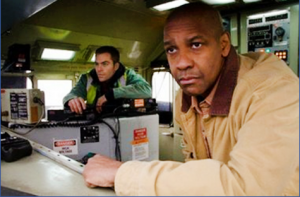 With the movie “Unstoppable” being released in theaters this Friday, I thought I’d share the official investigation by CSX Transportation regarding the actual incident that the movie is based on.
With the movie “Unstoppable” being released in theaters this Friday, I thought I’d share the official investigation by CSX Transportation regarding the actual incident that the movie is based on.
Synopsis
On May 15, 2001, at approximately 12:35 p.m., DST, an unmanned CSX yard train consisting of one model SD-40-2 locomotive, 22 loaded, and 25 empty cars, 2898 gross trailing tons, departed Stanley Yard, which is located in Walbridge, Ohio. The uncontrolled movement proceeded south for a distance of 66 miles before CSX personnel were able to bring the movement under control. At the time of the incident, the weather was cloudy with light rain. The ambient temperature was 55 degrees Fahrenheit. There was no derailment of equipment or collision. There were no reportable injuries as a result of the incident.
Circumstances Prior to Incident
Yard crew Y11615, consisting of one engineer, one conductor and one brakeman, reported for duty at Stanley Yard, Walbridge, Ohio, at 6:30 am, DST, May 15, 2001. After the normal job briefing with the trainmaster, crew Y11615 performed routine switching assignments until approximately 11:30 am, at which time the crew received new instructions and a second job briefing. A few minutes before 12:30 p.m., the crew entered the north end of track K12, located in the classification yard, with the intent to pull 47 cars out of K12 and then place these cars on departure track D10. Locomotive CSX 8888 was positioned with the short hood headed north. The engineer was seated at the controls on the east side of the locomotive.
The locomotive coupled to the 47 cars on track K12, as instructed and planned. The air hoses between the locomotive and the cars were not connected, as is normal during this kind of switching operation. The air brakes on the cars were therefore inoperative. The brakeman notified the engineer by radio to pull north from K12. After the rear or 47th car passed the brakeman’s location, he walked west to position the switch for the reverse movement to proceed into the assigned track D10.
The movement continued north out of K12 passing the conductor, who was positioned on the ground at the “Camera” switch. The conductor advised the engineer by radio of the number of cars that had passed him and received an acknowledgement from the engineer by radio.
The Incident
With eight cars remaining to pass over the “Camera” switch, the conductor notified the engineer by radio to prepare to stop. The engineer did not respond to his communication. The conductor again notified the engineer when four cars remained to clear the switch, but again there was no response from the engineer. The conductor then ordered the engineer to stop movement, but again there was no response from the engineer and the movement continued.
In his interview, the engineer stated that as he pulled north out of K12, he was notified by radio by the conductor that the trailing point switch for track PB9 off the lead was reversed. The engineer understood that it would be necessary for the movement to be stopped short of the PB9 switch in order to line the switch for movement further along the lead. Neither the conductor nor the brakeman were near the PB9 switch, and the engineer intended to stop his train, dismount from the locomotive, and align the switch to its normal position, if necessary. The speed of the movement up the lead had now reached 11 mph. The engineer observed the reversed switch, but due to the wet rail conditions and the number of cars coupled to his locomotive, he foresaw that he could not bring the equipment to a stop prior to passing through the misaligned switch.
The engineer responded by applying the locomotive’s independent brake to full application. The independent brake applies the brakes on the locomotive but does not apply the brakes on the individual freight cars. In addition, he reduced brake pipe pressure with a 20 psi service application of the automatic brake valve. The automatic brake is pneumatic braking system designed to control the brakes on the entire train. Still certain he would not stop short of the switch the engineer attempted to place the locomotive in dynamic brake mode. The dynamic brake utilizes the locomotive propulsion system to brake the train. Dynamic braking is analogous to down shifting a truck or automobile. Unfortunately, the engineer inadvertently failed to complete the selection process to set up the dynamic brake. Under the mistaken belief that he had properly selected dynamic brake, the engineer moved the throttle into the number 8 position for maximum dynamic braking. The engineer believed that the dynamic brake had been selected and that additional braking would occur. However, since dynamic brake set up had not been established, the placing of the throttle into the number 8 position restored full locomotive power, instead of retarding forward movement of the train.
While the train was still moving at a speed of approximately 8 mph, the engineer dismounted the locomotive and ran ahead to reposition the switch before the train could run through and cause damage to the switch. The engineer was successful in operating the switch just seconds before the train reached it. The engineer than ran along side the locomotive and attempted to reboard. However, the speed of the train had not decreased as the engineer had expected but had increased to approximately 12 mph. Due to poor footing and wet grab handles on the locomotive, the engineer was unable to pull himself up on the locomotives ladder. He dragged along for approximately 80 feet until he released his grip on the hand rails and fell to the ground.
Unable to reboard and stop the movement of his train, the engineer ran to contact a railroad employee, not a member of his crew but in possession of a radio, located at the north end of the yard. This employee immediately notified the yardmaster of the runaway train. The yardmaster promptly notified the Stanley tower block operator and the trainmaster. The Toledo Branch train dispatcher located in Indianapolis was also notified. The movement was now proceeding southward on the Toledo Branch (Great Lakes Division) governed by Traffic Control System (TCS) Rules. The time was approximately 12:35 p.m.
The brakeman observed the train depart the yard but did not initially see the engineer on the ground. The brakeman and another employee used a personal vehicle to pursue the train to the next grade crossing to attempt to board the train. Their immediate concern was for the safety of the engineer, who they feared may have suffered a heart attack while at the controls of the locomotive. At the grade crossing, the two employees were unable to board the train as the speed had increased to approximately 18 mph as it passed the mile post 4. Local authorities and the Ohio State Police were notified of the runaway train at approximately 12:38 p.m.
Attempts to Stop the Runaway
At a siding called Galatea, near mile post 34, at approximately 1:35 p.m., the train dispatcher remotely operated the switch for the train to enter the siding. Previously a portable derail had been placed on the track in an attempt to derail the locomotive and thereby stop the movement. The portable derail was, however, dislodged and thrown from the track by the force of the train passing over it, and the movement of the train was not impeded.
Northbound train Q63615 was directed by the dispatcher into the siding at Dunkirk, Ohio. The crew was instructed to uncouple their single locomotive unit from their train and wait until the runaway passed their location. at approximately 2:05 p.m., the runaway train passed Dunkirk, and the siding was lined for the crew of Q63615 to enter the main track and to pursue the runaway train.
At Kenton, Ohio, near mile post 67, the crew of Q63615 successfully caught the runaway equipment and succeeded in coupling to the rear car, at a speed of 51 mph. The engineer gradually applied the dynamic brake of his locomotive, taking care not to break the train apart. By the time the train passed over Route 31 south of Kenton, the engineer had slowed the speed of the train to approximately 11 mph. Positioned at the crossing was CSX Trainmaster Jon Hosfeld, who was able to run along side the unmanned locomotive and climb aboard. The trainmaster immediately shut down the throttle, and the train quickly came to a stop. The time was 2:30 p.m. and the runaway train had covered 66 miles in just under 2 hours.
An examination of the controls confirmed that the locomotive independent brake had been fully applied, automatic brake valve was in the service zone, and the dynamic brake selector switch was not in the braking mode. All brake shoes had been completely worn to the brake beams. The railroad was prepared to place an additional fully manned locomotive ahead of the runaway south of Kenton, if necessary, to further slow the train. This rather hazardous option was fortunately not required.
(To be continued in January 2011)
CSX announced its timetable for transitioning from wideband (25 KHz) to narrowband (12.5 KHz) railroad radio operation, the American Short Line & Regional Railroad Association reported on September 21, 2010. It is the first Class I railroad to furnish this information for dissemination. The Federal Communications Commission (FCC) has mandated the end of wideband two-way radio transmission for non-military purposes in the U.S. after Jan. 1, 2013. [See Technology, October 2010 TRAINS] The CSX timetable presently calls for the changeover to be completed entirely in 2011. Submitted by Chris Dees
As Autumn descends on the Midwest, Saturdays are usually set aside for that event known as College Game Day. October 16, 2010, was no exception in Lafayette, Indiana, as the familiar cheer of “Boiler Up – Hammer Down” erupted from Ross-Ade Stadium. However, on this Purdue Homecoming 2010, my friend Doug Buck and I had a different vision of what it means to “Boiler Up and Hammer Down” – one built back in 1907 by the Southern Railway. So we decided to invade “Illini Country” and head west to Monticello, Illinois to ride behind, photograph, and chase newly restored Southern Railway 2-8-0 number 401.
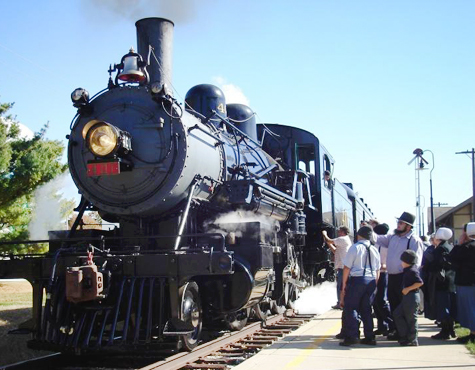
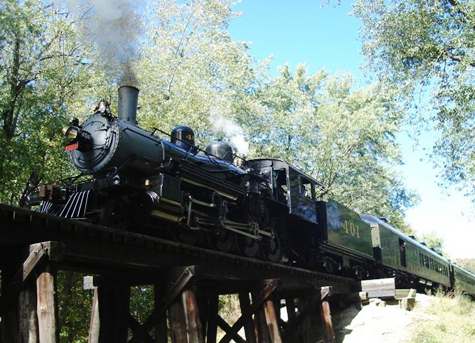
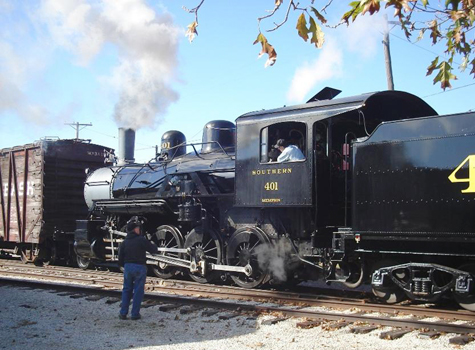
Ron Stubblefield – I first met Ron Stubblefield in Paducah, Kentucky, during my senior year at Murray State University. Ron had recently joined the Paducah Model Railroad Club and his HO-scale module had a lot of circus-related models: a carousel, a Ferris wheel, and even a Z-scale park train. In the coming months, Ron and I became good friends, culminating in Ron assisting me in getting my first job at Siemens in Ron’s hometown of Marion (KY). 1993 began with Ron and I traveling every Thursday night to Don Clayton’s house in Madisonville and the monthly NRHS meetings. Without Ron, I would not have had a chance to start my career the way I did, and I would not have met many other dear friends – the fellow members of the Western Kentucky Chapter of NRHS. I am forever indebted to Ron and his wife Kay.
Those weekly trips were more (than) just a ride to see trains. They were a small journey on the Ron-sized path of life. Sure, we saw the P&L Railway take over the Tradewater Railway through Marion, had CSX serenade us during dinner at Burger King in Madisonville, and chased multiple trains in that little Jeep across southern Illinois and Southeast Missouri – including the 1996 Olympic Torch train on Union Pacific. But Ron demonstrated what it was to be a real man – a kind of big brother (and I say that respectfully in terms of his physical size and the size of his heart). I would also not have been able to railfan many local hotspots had I not met Ron – those memories of racing down gravel roads and doing power slides in rural southeast Missouri in pursuit of UP and SP are and will continue to be cherished in the coming years. Ron also taught me a lot about railfan photography and was an incredible teacher of geology. Many of his photos graced multiple issues of our newsletters. And Ron’s knowledge of minerals and his involvement with the Clements Mineral Museum gave me a different view of “those rocks”.
In closing, I will miss my brother Ron. He was a good friend, a great mentor, and the best Christian brother a man could have. But I know, as my pastor Steve Viars would say: “this man knew that he knew that he knew he was on his way to Heaven.” I am sure Ron is enjoying railfanning in Heaven.
Run Eight Ron!!!
Chris (Dees)
Murrel Hogue was a fellow NRHS member, mileage collector, traveling companion with several Madisonville chapter members, and former Amtrak agent at Texarkana, TX. Many of his fellow mileage collectors would purchase Amtrak tickets through the Texarkana agency in order to support and keep the depot open.
Murrel’s many friends in railroading have discussed options for some permanent recognition of Murrel’s years of service and enthusiastic support for rail passenger service.
A bronze plaque is being prepared designating the Texarkana waiting room as the “Murrel Edward Hogue, Jr. Memorial Waiting Room.” A ceremony is planned to fomalize this designation, with a tentative date of August 28, 2010 in Texarkana. Once this date is finalized, additional details will be announced. It is hopeful that many of Murrel’s friends might be able to attend.
Contributions toward the cost of this memorial plaque may be sent to:
Griff Hubbard
1270 Brandywine Drive
Longview, TX 75601
With Best Regards,
Chris Dees